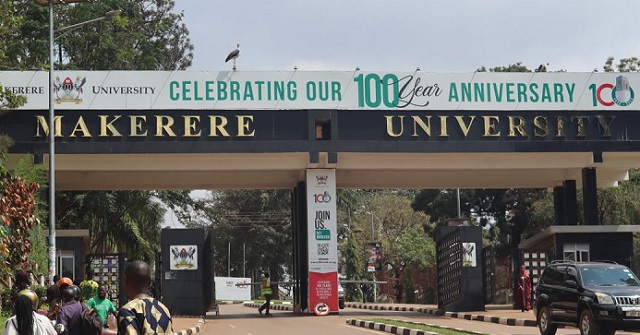
Kampala, Uganda | THE INDEPENDENT | Concerns have been raised by experts regarding the rankings that have placed Makerere University and four other universities in Uganda among the top higher education institutions in Sub-Saharan Africa.
The list, consisting of 88 universities (both public and private), highlights Nigeria as the country with the highest number of ranked institutions, with 37 universities, South Africa follows with nine, while Ghana and Kenya have seven each. Somalia and Uganda both have five universities listed.
Makerere University holds the fifth position, trailing behind the University of Pretoria, Muhimbili University of Health and Allied Sciences (Tanzania), the University of Johannesburg, and the University of the Witwatersrand, which claims the top spot.
In addition to Makerere University, several other Ugandan universities have also secured positions in the rankings. Metropolitan International University is ranked 34th, Kabale University holds the 48th spot, ISBAT University falls within the range of 51st to 60th, and Cavendish University is positioned between 61st and 70th.
These rankings were announced by Times Higher Education at the inaugural Sub-Saharan Africa Universities Forum, which took place at Ashesi University in Ghana. The forum focused on the actions required by universities in the region to provide impactful teaching and research, create sustainable opportunities for current and future students, and enhance citizenship across the continent.
During the ranking announcement, Phil Baty, the Chief Global Affairs Officer of Times Higher Education, described this ranking as a groundbreaking achievement, specifically tailored for African education organizations and spearheaded by them. He highlighted its significance for higher education in the continent. Baty further stated, “It clearly showcases the diverse strengths of a wide range of universities and uncovers several previously unknown distinctions between public and private universities, as evident from the outcomes of the student survey.”
Additionally, Baty expressed the hope that the ranking would serve as a means for African universities to acknowledge and highlight successful approaches, compare themselves to other institutions, and pinpoint areas for enhancement.
Furthermore, he emphasized the potential for universities to collaborate in addressing the challenges faced by the continent. “We also hope the ranking will be a valuable tool for the millions of parents and prospective students who are increasingly looking for authoritative information about what a university education will give them.” he added.
However, higher education experts have since poked holes in the Times Higher Education ranking saying it is not representative enough as it has not considered the known parameters that are usually followed while making university rankings.
According to Prof Isaiah Omolo Ndiege, a Kenyan higher education expert who once led Kyambogo University, the best university rankings should primarily focus on the output of the institution. This includes evaluating the quality and impact of graduates, the products and services generated by the university, as well as the research output that contributes to the creation of new knowledge benefiting communities.
Ndiege added that rankings should take into account the staff body and their capacities. This can involve factors such as the lecturer-to-student ratio, the availability of teaching facilities, and the quality of equipment provided. In Ndiege’s view, these elements are essential for any meaningful ranking, and if a ranking fails to consider them, it should be questioned or disregarded.
As Prof Ndiege points out, there are other rankings that consider factors such as research reputation, the learning and teaching environment, research impact, and internationalization as key components.
One example is the QS World University Rankings, which are widely recognized and accepted by many people. The QS ranking is conducted by the IREG Observatory on Academic Ranking and Excellence, an international non-profit association of ranking organizations, universities, and other bodies interested in university rankings and academic excellence.
According to the recent QS ranking, Makerere University was placed 22 in Africa, with a global ranking range of 1201-1400. Makerere has also experienced a decline in its position compared to previous rankings. In the specific indicators used by QS, Makerere University scored 3.7 per cent in the faculty-student ratio and 4.6 per cent in citations per staff, which is a factor weighted at 20 per cent. The ranking provides additional statistics in each area of assessment.
In this particular ranking, Makerere University falls behind institutions like the University of the Western Cape, the University of Nairobi, North-West University, Rhodes University, and the University of KwaZulu-Natal. These universities were not listed in the Times Higher Education ranking.
These variations in rankings highlight the diverse methodologies and indicators used by different ranking systems, leading to variations in the positions of universities. It is important for institutions and stakeholders to consider multiple rankings and their respective methodologies to gain a comprehensive understanding of an institution’s standing.
Webometrics is another ranking system that has been active since 2004. According to it, Makerere University is ranked 9th among Sub-Saharan African universities (excluding North Africa). The nearby universities from Uganda, such as Kampala International University, are positioned at 32nd, Mbarara University of Science and Technology at 61st, Kyambogo University at 98th, Gulu University at 109th, Busitema University at 119th, and Uganda Martyrs University at 148th, among others.
Unlike QS, Webometrics employs a composite indicator that considers the volume of web content (number of web pages and files) as well as the visibility and impact of these web publications based on the number of external links or site citations they receive to rank universities. In a press statement issued by Times Higher Education, they emphasized the inclusion of direct speech where they stated, “a unique student survey accounting for their experiences” as a crucial factor in determining the rankings.
The survey revealed that students enrolled in private universities generally expressed higher satisfaction levels compared to their peers in public universities. This satisfaction was measured based on factors such as facilities, peer interactions, faculty engagement, employability, course quality, and teaching involvement.
To Ndiege, while gathering input from students can be valuable, it should not be given excessive weight in the ranking process. He points out that students may not always provide unbiased or objective information, as they may feel inclined to defend their alma mater. Therefore, while student feedback can be considered, it should be balanced with other objective criteria to ensure a comprehensive and accurate assessment of universities.
Rev Fr Prof John Chrysostom Maviiri, another higher education expert and retired vice chancellor, shares a similar viewpoint to Prof Ndiege regarding university rankings. While acknowledging the potential benefits of rankings in terms of quality assurance and improvement, he agrees that many rankings lack a well-defined and universally accepted standard that should be followed.
Prof Maviiri also raises concerns about the possibility of individual universities indirectly or directly influencing rankings to their advantage. This manipulation could be aimed at projecting a better image, attracting funding, and attracting students, among other benefits. These considerations highlight the potential biases and limitations that can arise in the ranking process. Overall, Prof Maviiri cautions that rankings should be approached critically, keeping in mind their potential limitations and the need for a standardized and transparent framework.
From Prof Maviiri’s perspective, if a more effective ranking system is to be developed, all universities in the region should come together and establish a body responsible for determining the parameters and indicators to be used in ranking the institutions. This collaborative approach would ensure that the rankings are based on agreed-upon criteria that are relevant and meaningful to the universities in the region.
However, if reaching a consensus on a unified ranking system proves to be challenging, Prof Maviiri suggests that the rankings can be disregarded. Instead, each individual institution should focus on fulfilling its mission, vision, and objectives as these serve as the fundamental parameters for assessing a university.
When asked to clarify the criteria used to rank the universities, Ben Miller the Communications manager at Times Higher Education, said the Sub-Saharan Africa University Rankings is open to all universities in the region that teach undergraduate level. He added that a minimum of 50 validated student survey responses and validated institutional data is required to be included in the ranking.
“To participate in the rankings, a university needs to submit the required data and distribute the student survey to its current students. The Sub-Saharan Africa University Ranking uses a hybrid methodology with a focus on the unique features of the region, developed through extensive engagement with university leaders across the region, under a project initiated by a consortium of African and international higher education organisations,” Miller said adding that now that they have launched the inaugural rankings, they hope it will encourage many more universities in Uganda, and across the region, to participate next year.
*****
URN
 The Independent Uganda: You get the Truth we Pay the Price
The Independent Uganda: You get the Truth we Pay the Price


